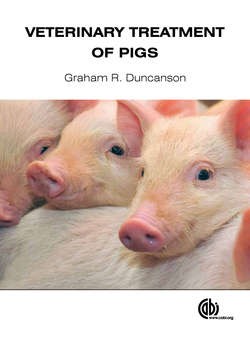Читать книгу Veterinary Treatment of Pigs - Graham R Duncanson - Страница 119
На сайте Литреса книга снята с продажи.
Two-person post-mortem technique or single-handed technique using a cradle
ОглавлениеThe pig is laid in dorsal recumbency with the helper holding one leg to keep it upright or laid in the cradle. A skin incision is made from the chin straight down the ventral surface all the way to the anus. A small incision is carefully made through the abdominal musculature and the peritoneum caudal to the xiphisternum. This incision is then lengthened caudally to the pubic symphysis, making sure that the internal organs are not cut. Two cuts are made from the xiphisternum cranially through the costalchondral junctions so that the sternum can be removed. The internal organs can then be examined in situ. Bacteriological samples can be taken at this stage. The pluck and the intestinal tract can then be removed as described above.
The internal organs etc. to be examined in the abdominal cavity are: the umbilicus together with the whole internal peritoneal surface, the liver including the gall bladder, the spleen, kidneys and adrenals, the ureters, bladder and urethra, the uterus, fallopian tubes, ovaries and mammary glands, the testes, vesicular gland, bulbourethral glands and the penis.
The alimentary tract can be examined starting with: the tongue, lips, teeth, pharynx and oesophagus, the stomach (noting contents), the duodenum, jejunum and ileum, the colon, caecum and rectum, the mesenteric lymph nodes and the pancreas.
The respiratory tract and thoracic cavity can be examined starting with: the snout and turbinates, the larynx, trachea and lungs, the heart, thymus and mediastinal lymph nodes.
The neurological system can be examined after the cranium and the spinal column have been opened. Bacteriological samples can be taken at this stage. The brain, spinal column and peripheral nerves should all be examined.
